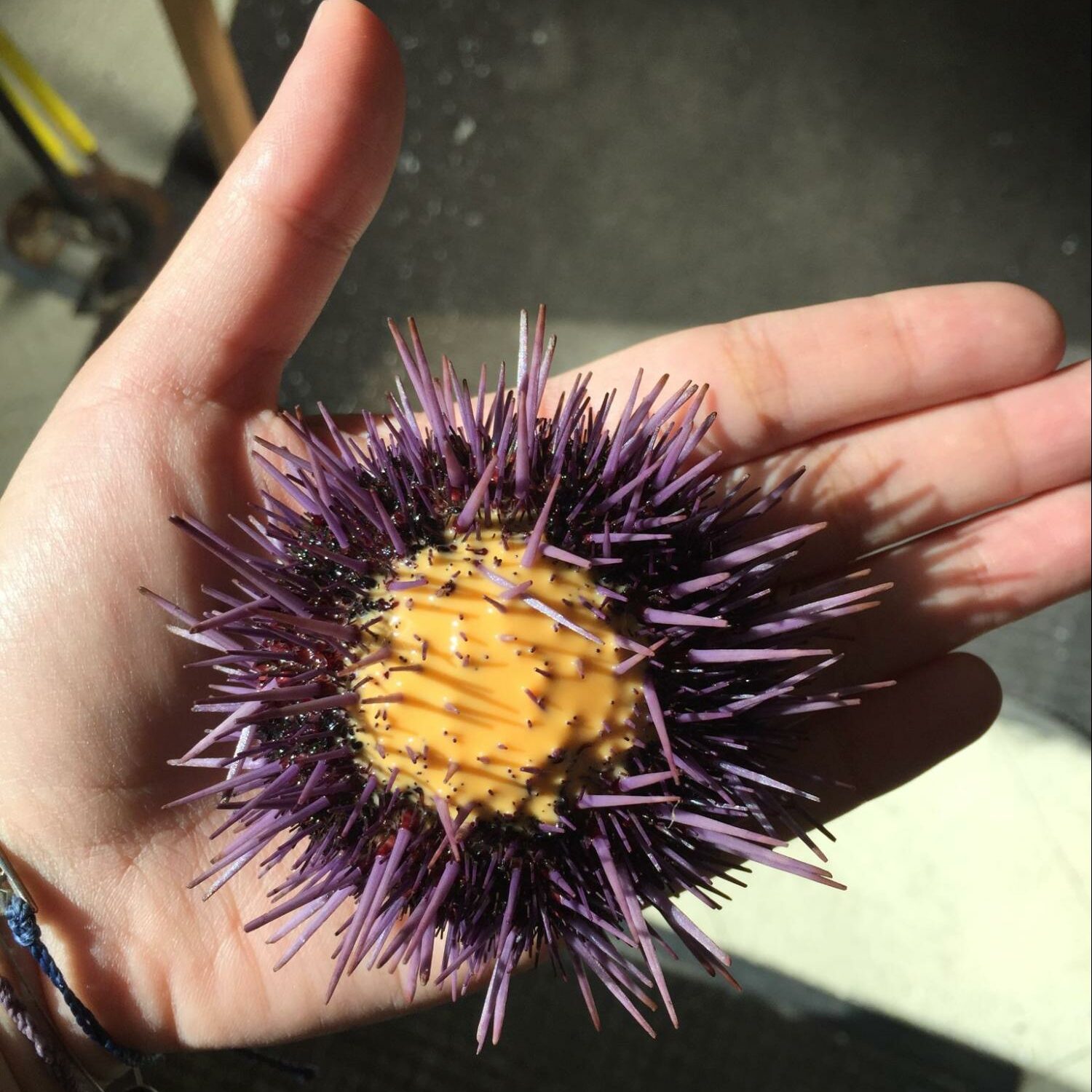Purple sea urchin embryos whose mothers were exposed to heatwaves have greater tolerance to high temperatures, suggesting a pathway to resilience for this keystone species in kelp forests.
by Isabela Lima-Borges, PhD student at the Kellogg Biological Station LTER.
Effects of rising ocean temperatures on kelp forests
The increased frequency of marine heatwaves is one of the main impacts of global change in marine environments. The notable Pacific coast heatwave of 2014-2016, nicknamed “the Blob,” was monitored by scientists at the Santa Barbara Coastal LTER and had severe consequences on the diverse and productive kelp forest communities in California.

Credit: Photo credit: Jannine Chamorro, CC BY-SA 4.0.
Purple sea urchins structure kelp communities by eating large amounts of kelp, regulating its availability as a food resource to other organisms (Yorke et al. 2019). Over time, scientists at the SBC noted that the timing of heatwaves often lined up with the timing of purple urchin reproduction. “We started to see that temperature has a big effect on urchins, not only at the adult stage but at larval stages as well. In tandem, we started seeing more of these marine heatwaves that were happening in the [Santa Barbara] Channel and that got us curious,” recounted PhD student Jannine Chamorro. Chamorro’s team found that urchin embryos from parents that experienced a marine heatwave during reproduction were more resilient to warmer ocean temperatures than their counterparts raised during normal ocean conditions. As a consequence, it is possible that future urchin populations may be more resilient to the negative effects of heatwaves.
Can urchins withstand marine heatwaves?
In a paper recently published in Frontiers in Marine Science, Chamorro and colleagues used a laboratory experiment to test how the exposure of urchins to heatwave temperatures during reproduction affected their offspring. They were specifically interested in whether those offspring would be better able to withstand high temperatures when compared to individuals from parents that did not go through heatwaves. While the link between urchin reproduction and marine heatwaves was first noticed in the field, Chamorro decided to simulate marine heatwave temperatures in a laboratory setting to control for other factors that may occur concurrently alongside heatwaves (e.g. increased disease, change in kelp nutritional quality). “At the SBC LTER we have all these sites with different sensors that are able to document different abiotic conditions such as temperature, dissolved oxygen, pH. Using that data, I was able to look at what temperatures look like in the Santa Barbara Channel” during these heatwaves, said Chamorro.

Credit: Photo credit: Jannine Chamorro, CC BY-SA 4.0.
Using the long-term dataset from SBC, she was able to parameterize her experiment to mimic heatwave conditions in which to rear wild-caught urchins in the lab. Once the experiment was set up, Chamorro’s team could isolate the effects of heatwave temperatures on adult urchins’ survival, reproduction, and provisioning of their offspring, as well as test how offspring from different mothers (exposed to heatwave vs. not) responded to high temperatures. Chamorro and her team found that urchins acclimated to warmer temperatures tended to produce eggs that were more protein-rich, and that the resulting urchin larvae had higher thermal tolerance than those with parents who were not exposed to warmer temperatures. “There may be a positive effect that primes them to live in more stressful conditions,” Chamorro summarized.
This parent-to-offspring effect is called “transgenerational plasticity,” where the conditions to which parents are exposed can affect traits in their offspring. The term “plasticity” describes how the same individual can change in response to different conditions, and is an important factor in adaptation to rapid climate change because it can occur rapidly. These findings suggest that transgenerational plasticity may help urchins that develop in heatwave conditions withstand heatwaves better than their parents could. This increased resilience in keystone purple urchin populations could have major consequences for the effects of temperature on kelp forest communities as a whole, as urchins determine kelp abundances and regulate kelp availability for other organisms.

Credit: Jannine Chamorro, CC BY-SA 4.0.
Putting observational data to experimental use
This experimental study adds to a growing body of work at the SBC LTER that looks at how the presence and timing of heatwaves affects marine life. “We used the field conditions to inform our laboratory experiments, but we also have had past and ongoing [field] studies where we put urchins […] inside vs. outside of the kelp forest to look at how environmental factors that exist in those two different spaces impacts urchin transgenerational plasticity,” explained Chamorro. This combination of field and lab studies allows for both a holistic understanding of how complex natural habitats are changing, and a more controlled mechanistic look at the effects of specific drivers of change, such as temperature.
As a whole, this body of work requires a long-term understanding of local temperature conditions in the Santa Barbara Channel to define marine heatwaves, the ability to have experiments in the field, and a way to link controlled laboratory experiments to the observed patterns in the wild. By repurposing the observational SBC LTER temperature dataset to parameterize her experiments, Chamorro and her team not only made those experiments more realistic, but now they can also compare and integrate their lab results with field data. This combination of observation and experimentation sheds light on the specific pressures that marine life must respond to in an age of complex and ongoing climate change. As Chamorro summarized, “the LTER is great because we’re able to come at this question from a lot of different angles.”










